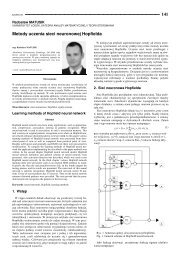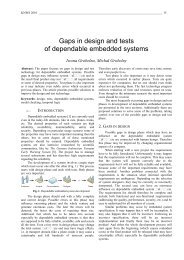Deadlock detection in networks of automata communicating via flags
Deadlock detection in networks of automata communicating via flags
Deadlock detection in networks of automata communicating via flags
You also want an ePaper? Increase the reach of your titles
YUMPU automatically turns print PDFs into web optimized ePapers that Google loves.
KNWS 2010 ______________________________________________________________________________ 245<br />
<strong>Deadlock</strong> <strong>detection</strong> <strong>in</strong> <strong>networks</strong> <strong>of</strong> <strong>automata</strong><br />
communicat<strong>in</strong>g <strong>via</strong> <strong>flags</strong><br />
Andrei Karatkevich<br />
Abstract: A range <strong>of</strong> digital systems can be represented as<br />
the state mach<strong>in</strong>e <strong>networks</strong> <strong>in</strong> which FSMs communicate<br />
with the help <strong>of</strong> flip-flops. The article presents<br />
a methodology <strong>of</strong> detect<strong>in</strong>g possible deadlocks <strong>in</strong> such<br />
<strong>networks</strong>. The methodology is illustrated by apply<strong>in</strong>g it to<br />
a project <strong>of</strong> a pipel<strong>in</strong>e processor.<br />
Keywords: State mach<strong>in</strong>es, system design, verification,<br />
graph-schemes, pipel<strong>in</strong>e.<br />
1. INTRODUCTION<br />
F<strong>in</strong>ite state mach<strong>in</strong>e (FSM), or f<strong>in</strong>ite automaton, is<br />
a model widely used <strong>in</strong> digital system design. Model<strong>in</strong>g <strong>of</strong><br />
complex systems, however, <strong>of</strong>ten requires us<strong>in</strong>g more than<br />
one state mach<strong>in</strong>e. Several <strong>automata</strong> can be composed <strong>in</strong>to<br />
a network. For such <strong>networks</strong>, different ways <strong>of</strong><br />
communication between the <strong>automata</strong> are used.<br />
Automata can be connected directly (that means that<br />
the <strong>in</strong>put <strong>of</strong> one automaton can be connected to the output<br />
<strong>of</strong> another one). But it is <strong>in</strong>convenient to consider <strong>in</strong>puts<br />
and outputs <strong>of</strong> the <strong>automata</strong> <strong>in</strong> such <strong>networks</strong> as s<strong>in</strong>gle<br />
symbols, as it is done <strong>in</strong> classical <strong>automata</strong> theory. More<br />
flexible and popular approach, allow<strong>in</strong>g to represent easily<br />
Mealy and Moore (and mixed) <strong>automata</strong> with multiple<br />
outputs, uses the concept <strong>of</strong> broadcast events. It is applied<br />
<strong>in</strong> various models <strong>of</strong> concurrent f<strong>in</strong>ite state mach<strong>in</strong>es [2,5].<br />
This fits perfectly well for the systems <strong>of</strong> logical control,<br />
but may be not enough for more complex cases, as<br />
model<strong>in</strong>g the structure <strong>of</strong> processors. Then the <strong>flags</strong><br />
(variables) may be used as one <strong>of</strong> the ways <strong>of</strong><br />
communication between <strong>automata</strong> [6]. Difference between<br />
<strong>flags</strong> and events is that an event has a short life (occurs<br />
only dur<strong>in</strong>g an <strong>in</strong>stant <strong>of</strong> time, unless it is not generated<br />
aga<strong>in</strong> and aga<strong>in</strong> by an active state, as “do” events <strong>in</strong><br />
Statecharts [5]), and a flag keeps a value which is assigned<br />
to it by an action until another action sets another value.<br />
In many models more complex dataflow doma<strong>in</strong>s are<br />
used [1,6]. But even for complex cases analysis <strong>of</strong><br />
simplified models can provide some important <strong>in</strong>formation<br />
for verification. Detection <strong>of</strong> deadlocks (the situations <strong>in</strong><br />
which two or more <strong>automata</strong> are wait<strong>in</strong>g for some action<br />
<strong>of</strong> each other, so all <strong>of</strong> them are blocked) is one <strong>of</strong> the<br />
most important verification tasks. <strong>Deadlock</strong> <strong>detection</strong> <strong>in</strong><br />
the FSM <strong>networks</strong> with communication <strong>via</strong> events is<br />
considered <strong>in</strong> [3]. Here we consider the same task for the<br />
FSM <strong>networks</strong> with communication <strong>via</strong> b<strong>in</strong>ary <strong>flags</strong>.<br />
A project <strong>of</strong> a pipel<strong>in</strong>e processor is used for an example.<br />
2. AN EXAMPLE: A PIPELINE PROCESSOR<br />
As an example we use a project <strong>of</strong> a basic pipel<strong>in</strong>e<br />
RISC processor with high performance, designed as<br />
a diploma project by Ilan Kutzman and Alex Raitz<strong>in</strong> at Bar<br />
Ilan University, Israel, supervised by Pr<strong>of</strong>. Samary<br />
Baranov [4]. Figs 1-4 show the Algorithmic State<br />
Mach<strong>in</strong>es (ASMs) [1] with generalized operators (not<br />
expanded here), specify<strong>in</strong>g behavior <strong>of</strong> four pipel<strong>in</strong>e<br />
stages. The fifth stage (Write stage) is not shown here, as<br />
less important for deadlock <strong>detection</strong>. This example has<br />
more than 10 9 states.<br />
Fig. 1. Fetch stage<br />
3. ANALYSIS PROCESS<br />
3.1. CONSTRUCTING OF THE MODEL<br />
To create a model with reduced complexity<br />
(consist<strong>in</strong>g <strong>of</strong> FSMs, not ASMs) an abstraction can be<br />
used. At this step we are go<strong>in</strong>g to abandon the<br />
computation <strong>of</strong> variables and to consider only the s<strong>in</strong>gle<br />
Boolean variables to which concrete values are assigned<br />
by concrete operators (process<strong>in</strong>g steps). In the given<br />
system there are follow<strong>in</strong>g such variables (<strong>flags</strong>): Fop1B,<br />
Fop2B, FImB, BranChk, BIP, IEN, FGO and FGI.
246 ______________________________________________________________________________ KNWS 2010<br />
AND, ADD and SUB INC, DEC and COM STR <strong>in</strong>struction<br />
AND, ADD, SUB, SHL, SHR,<br />
CIL, CIR, INC, DEC, COM LOD <strong>in</strong>struction INP <strong>in</strong>struction STR <strong>in</strong>struction<br />
OUT <strong>in</strong>struction IOF <strong>in</strong>struction ION <strong>in</strong>struction<br />
Fig. 2. Operands1 stage<br />
BCC <strong>in</strong>struction<br />
BCZ <strong>in</strong>struction<br />
Beg<strong>in</strong><br />
S<br />
0<br />
1<br />
Fig. 4. Implement stage<br />
3.2. BUILDING AND ANALYSIS OF WFG<br />
Now we are go<strong>in</strong>g to construct a Wait-for graph<br />
(WFG) [8] – a k<strong>in</strong>d <strong>of</strong> dependency graph, <strong>in</strong> which nodes<br />
represent processes, and arcs represent blockages. In our<br />
graph nodes will correspond to the <strong>automata</strong>. An arc from<br />
automaton A i to A j means that A j has a state <strong>in</strong> which it is<br />
wait<strong>in</strong>g for certa<strong>in</strong> value <strong>of</strong> flag x, and A i has a state <strong>in</strong><br />
which it assigns this value to x. The arc is labeled by x<br />
( x ), if A j waits for value 1 (0). The difference between<br />
this graph and the WFG used for deadlock <strong>detection</strong> <strong>in</strong><br />
operat<strong>in</strong>g systems is that it is constructed not for a current<br />
situation but for all possible dependencies <strong>in</strong> given system.<br />
Flags FGO and FGI cannot cause a deadlock,<br />
because no value <strong>of</strong> them can block any automaton. Let us<br />
construct the WFG represent<strong>in</strong>g dependencies <strong>via</strong> the rest<br />
<strong>of</strong> <strong>flags</strong>. It is shown <strong>in</strong> fig. 5.<br />
If there is a deadlock, there is a correspond<strong>in</strong>g cycle<br />
<strong>in</strong> the WFG. But exist<strong>in</strong>g <strong>of</strong> a cycle is not a sufficient<br />
condition <strong>of</strong> a deadlock. For example, there is a cycle<br />
between Write and Impl nodes, but it does not <strong>in</strong>dicate any<br />
deadlock, because it would imply that flag FwrB has value<br />
0 and 1 at the same time. A cycle <strong>in</strong> the WFG means<br />
cyclic wait<strong>in</strong>g, if for any literal label<strong>in</strong>g an arc <strong>in</strong> it, its<br />
complement does not appear <strong>in</strong> the cycle. Then a deadlock<br />
is possible, if the <strong>flags</strong> have values turn<strong>in</strong>g the literals<br />
appear<strong>in</strong>g <strong>in</strong> the cycle to 1, and the <strong>automata</strong> are <strong>in</strong> the<br />
correspond<strong>in</strong>g states. We call such cycle a deadlock cycle.<br />
FOp2B<br />
1<br />
0<br />
BranChk:=1<br />
BIP:=1<br />
IR1o2<br />
(5) 1<br />
0<br />
IR1o2<br />
(7) 1<br />
0<br />
IR1o2<br />
IR1o2<br />
0 (6)<br />
0 (6)<br />
1 1<br />
Op2o2:=IR2<br />
o2<br />
BIP:=0<br />
IR1o2:=x"0000"<br />
FOp2B:=0<br />
BCF <strong>in</strong>struction<br />
End<br />
BUN <strong>in</strong>struction<br />
Fig. 3. Operands2 stage (only ASMs for the branch<br />
<strong>in</strong>structions are shown)<br />
Fig. 5. Wait-for graph for the pipel<strong>in</strong>e processor
KNWS 2010 ______________________________________________________________________________ 247<br />
All cycles <strong>in</strong> an oriented graph can be generated by<br />
the algorithm described <strong>in</strong> [7]. As far as number <strong>of</strong> cycles<br />
<strong>in</strong> a graph depends exponentially on its size, it is<br />
reasonable to simplify the graph by remov<strong>in</strong>g the nodes<br />
which cannot belong to the cycles which are <strong>in</strong>terest<strong>in</strong>g for<br />
us. Such simplification can be performed step by step<br />
(remov<strong>in</strong>g <strong>of</strong> some nodes can allow remov<strong>in</strong>g the<br />
follow<strong>in</strong>g ones). Of course any node which <strong>in</strong>degree or<br />
outdegree is 0 can be removed, because it cannot belong to<br />
any cycle. Also, if every <strong>in</strong>com<strong>in</strong>g arc <strong>of</strong> a node is labeled<br />
by a literal and every outgo<strong>in</strong>g arc is labeled by its<br />
complement, this node cannot belong to a deadlock cycle.<br />
That is the case for node Write: its <strong>in</strong>com<strong>in</strong>g arc is labeled<br />
by FwrB, and both outgo<strong>in</strong>g arcs are labeled by FwrB .<br />
But after remov<strong>in</strong>g node Write from the graph, node Impl<br />
turns to be <strong>in</strong> similar situation: now every its <strong>in</strong>com<strong>in</strong>g arc<br />
is labeled by FimB, and every outgo<strong>in</strong>g – by FimB . That<br />
means that Impl also cannot be deadlocked.<br />
Further simplification can be performed by remov<strong>in</strong>g<br />
some arcs. If every <strong>in</strong>com<strong>in</strong>g arc <strong>of</strong> a node is labeled by<br />
the same literal, then no outgo<strong>in</strong>g arc labeled by its<br />
complement can belong to a deadlock cycle. Every such<br />
outgo<strong>in</strong>g arc can be removed. In our example, both<br />
<strong>in</strong>com<strong>in</strong>g arcs <strong>of</strong> Oper2 have labels Fop2B. Then two<br />
outgo<strong>in</strong>g arcs labeled by Fop2 B can be removed. It<br />
implies the situation <strong>in</strong> which Oper1 has only one<br />
<strong>in</strong>com<strong>in</strong>g arc labeled with Fop1B, which means that the<br />
arc from Oper1 to Fetch can be removed. The simplified<br />
graph is shown <strong>in</strong> fig. 6.<br />
This graph, as it is easy to see now, has 4 deadlock<br />
cycles. But one may note that some <strong>of</strong> them <strong>in</strong> a sense<br />
cover others. For any cycle FetchOper1Oper2Fetch<br />
there is a cycle FetchOper2Fetch, labeled with the<br />
same literals except Fop1B. That means that stages Fetch,<br />
Operands1 and Operands2 can be mutually blocked, only<br />
if Fetch and Operands2 are mutually blocked. So it is<br />
enough to check possibility <strong>of</strong> two deadlocks:<br />
correspond<strong>in</strong>g to cycles Fetch <br />
Fop <br />
2B<br />
Oper2<br />
<br />
BranChk Fetch and Fetch <br />
B <br />
Fop 2 Oper2 BIP <br />
Fetch. Other deadlocks are not possible <strong>in</strong> this system.<br />
Fig. 6. Reduced Wait-for graph<br />
3.3. CHECKING REACHABILITY OF THE<br />
DEADLOCKS<br />
Exist<strong>in</strong>g <strong>of</strong> a deadlock cycle <strong>in</strong> the WFG means, that<br />
there exists a comb<strong>in</strong>ation <strong>of</strong> states <strong>of</strong> <strong>automata</strong>, <strong>in</strong> which<br />
they are deadlocked, but it does not always mean that such<br />
comb<strong>in</strong>ation is reachable from the <strong>in</strong>itial state <strong>of</strong> the<br />
system. Now, similarly as it was proposed for deadlock<br />
analysis <strong>in</strong> Statecharts [3], after <strong>detection</strong> <strong>of</strong> possibility <strong>of</strong><br />
deadlocks by means <strong>of</strong> structural analysis, it is necessary<br />
to check reachability <strong>of</strong> possible deadlocks.<br />
To simplify this check, let us use the reduced<br />
flowcharts represent<strong>in</strong>g only the behavior related to<br />
read<strong>in</strong>g or writ<strong>in</strong>g the <strong>flags</strong> appear<strong>in</strong>g <strong>in</strong> the reduced WFG<br />
(Fop1B, Fop2B, BranChk, BIP). The fragments <strong>of</strong><br />
<strong>automata</strong> which have noth<strong>in</strong>g to do with the <strong>flags</strong> can be<br />
reduced. Identical fragments can be fused. Such reduced<br />
representation <strong>of</strong> Fetch stage is presented <strong>in</strong> fig. 7.<br />
As one can see, at this level we represent the system<br />
as a nondeterm<strong>in</strong>istic state mach<strong>in</strong>e. Here big rounds mean<br />
fragments <strong>of</strong> the automaton graph which neither read nor<br />
write the <strong>flags</strong> we are <strong>in</strong>terested <strong>in</strong>. They can end up <strong>in</strong><br />
more than one state, depend<strong>in</strong>g on the <strong>in</strong>puts we abstract<br />
here. That’s why they may have multiple outputs. Small<br />
rounds mean the states <strong>in</strong> which the automaton waits for<br />
a value <strong>of</strong> a flag. Only <strong>in</strong> such states it can be deadlocked.<br />
As follows from the WFG, the only states <strong>in</strong> which the<br />
Fetch stage can be deadlocked are a and d.<br />
Reduced representations <strong>of</strong> Operands1 and<br />
Operands2 are shown <strong>in</strong> fig. 8. There is only one<br />
possibility for stage Operands2 to be deadlocked: if it is<br />
blocked <strong>in</strong> state a, i.e. at the very beg<strong>in</strong>n<strong>in</strong>g. Analysis <strong>of</strong><br />
the state space <strong>of</strong> the reduced flowcharts demonstrates<br />
that, assum<strong>in</strong>g that <strong>in</strong>itially all <strong>flags</strong> have value 0, a<br />
deadlock correspond<strong>in</strong>g to the cycle<br />
<br />
<br />
Fetch<br />
Fop 2B<br />
Oper2 <br />
BIP Fetch is not possible.<br />
Indeed, Fetch can be blocked <strong>in</strong> state d (wait<strong>in</strong>g for<br />
BIP=0) only when BIP=1, BIP can be set to 1 only by<br />
Operands2, and Operands2 always sets BIP to 0<br />
afterwards and cannot be blocked between these two<br />
operators.<br />
The last potential deadlock we have to consider is<br />
when Fetch is <strong>in</strong> state a (wait<strong>in</strong>g for BranChk=1) and<br />
Operands2 is <strong>in</strong> its state a (wait<strong>in</strong>g for Fop2B=1). At the<br />
level <strong>of</strong> the reduced flowcharts it seems to be possible: for<br />
example, if Fetch immediately enters state a, both<br />
Operands stages cannot leave their <strong>in</strong>itial states. Such<br />
analysis is not enough <strong>in</strong> our case, because transitions<br />
between states <strong>in</strong> the stages <strong>of</strong> pipel<strong>in</strong>e processor are not<br />
<strong>in</strong>dependent. So we have to turn to the detailed description<br />
<strong>of</strong> the pipel<strong>in</strong>e processor and to check whether this<br />
deadlock is <strong>in</strong>deed possible.<br />
Analysis at the level <strong>of</strong> detailed descriptions shows<br />
that, accord<strong>in</strong>g to the generalized operator CheckBranch<br />
(which details are not shown here), Fetch stage can enter<br />
the state <strong>of</strong> wait<strong>in</strong>g for BranChk=1 only when there is<br />
branch <strong>in</strong>struction <strong>in</strong> Operands2 stage. It means that it<br />
cannot happen from the very beg<strong>in</strong>n<strong>in</strong>g <strong>of</strong> system<br />
function<strong>in</strong>g, because each stage ma<strong>in</strong>ta<strong>in</strong>s its own copy <strong>of</strong><br />
<strong>in</strong>struction, and the copy for Operands2 can be written<br />
only by operator Fetch2Oper2 (Fetch) or Oper12Oper2<br />
(Operands1). First two stages can function avoid<strong>in</strong>g<br />
execut<strong>in</strong>g these operators (Operands2 stage is skipped for
248 ______________________________________________________________________________ KNWS 2010<br />
some <strong>in</strong>structions – see figs 1 and 2). However, as far as<br />
Operands2 clears IR1O2 register, which conta<strong>in</strong>s this<br />
stage’s copy <strong>of</strong> <strong>in</strong>struction (see fig. 3), and flag Fop2B is<br />
set to 1 always together with writ<strong>in</strong>g the <strong>in</strong>struction to<br />
IR1O2, the situation <strong>in</strong> which both Fetch and Operands2<br />
stages are wait<strong>in</strong>g for each other is not possible. So, we<br />
have shown that the system is deadlock-free.<br />
1<br />
1<br />
a<br />
BranChk<br />
BranChk:=0<br />
BIP<br />
d<br />
BIP<br />
0<br />
2<br />
e<br />
Beg<strong>in</strong><br />
0<br />
1<br />
b<br />
Fop1B<br />
1 0<br />
1<br />
Fop1B<br />
0<br />
Fop1B:=1<br />
0<br />
c<br />
Fop2B<br />
3<br />
f<br />
0<br />
0<br />
Fop1B<br />
g<br />
0<br />
Fop2B<br />
0<br />
1<br />
1<br />
1<br />
1<br />
simulation never ensures detect<strong>in</strong>g all possible bugs (<strong>in</strong><br />
this case deadlocks), and formal analysis like proposed <strong>in</strong><br />
this paper does ensure.<br />
4. SUMMARY<br />
The proposed method consists <strong>of</strong> the follow<strong>in</strong>g steps.<br />
1. Construct<strong>in</strong>g an FSM network model <strong>of</strong> the analyzed<br />
system.<br />
2. Construct<strong>in</strong>g a Wait-for graph describ<strong>in</strong>g dependencies<br />
between the <strong>automata</strong>.<br />
3. Reduc<strong>in</strong>g the WFG by remov<strong>in</strong>g nodes and arcs which<br />
cannot be visited by any deadlock cycle.<br />
4. Generat<strong>in</strong>g all deadlock cycles <strong>in</strong> the reduced WFG. If<br />
there are no such cycles, the system is deadlock-free.<br />
5. Reduc<strong>in</strong>g the fragments <strong>of</strong> the <strong>automata</strong> <strong>in</strong> the network<br />
which do not deal with the selected <strong>flags</strong>.<br />
6. Check<strong>in</strong>g whether the potential deadlocks detected <strong>in</strong><br />
step 4 are reachable <strong>in</strong> the reduced network. If not, the<br />
system is deadlock-free.<br />
7. Check<strong>in</strong>g whether the potential deadlocks, not<br />
excluded <strong>in</strong> step 6, are reachable <strong>in</strong> the analyzed<br />
system.<br />
The method can be used for formal verification <strong>of</strong><br />
a wide range <strong>of</strong> systems with parallel logical control units.<br />
It allows detect<strong>in</strong>g, without much computational effort and<br />
without exploration <strong>of</strong> most <strong>of</strong> the state space, deadlocks<br />
possible <strong>in</strong> a system or ensur<strong>in</strong>g that it is deadlock-free.<br />
ACKNOWLEDGEMENT<br />
I am grateful to Samary Baranov for <strong>in</strong>spiration,<br />
fruitful discussions and for the example described <strong>in</strong> [4].<br />
b<br />
Fop2B<br />
0<br />
1<br />
Fop1B:=0<br />
Fop2B:=1<br />
End<br />
Fop2B:=1<br />
Fig. 7. Reduced flowchart <strong>of</strong> the Fetch stage<br />
Beg<strong>in</strong><br />
a<br />
Fop1B<br />
1<br />
2<br />
1<br />
End<br />
0<br />
Fop1B:=0<br />
Operands1 stage<br />
Fop2B:=0<br />
Beg<strong>in</strong><br />
a<br />
Fop2B<br />
1<br />
1<br />
BranChk:=1<br />
BIP:=1<br />
2<br />
BIP:=0<br />
Fop2B:=0<br />
End<br />
Operands2 stage<br />
0<br />
BranChk:=1<br />
BIP:=0<br />
Fig. 8. Reduced flowchart <strong>of</strong> the Operands1 and<br />
Operands2 stages<br />
Note that <strong>in</strong> the <strong>in</strong>itial design described <strong>in</strong> [4] there<br />
was no zero<strong>in</strong>g <strong>of</strong> IR1O2 after every branch, and the<br />
deadlock correspond<strong>in</strong>g to the cycle<br />
Fetch <br />
Fop <br />
2B<br />
Oper2 BranChk <br />
Fetch was possible.<br />
It was discovered dur<strong>in</strong>g simulation <strong>of</strong> the design. But<br />
REFERENCES<br />
[1] Baranov S., Logic and System Design <strong>of</strong> Digital<br />
Systems. Tall<strong>in</strong>n, TGU, 2008.<br />
[2] Harel D., “Statecharts: a visual formalism for<br />
complex systems”, Science <strong>of</strong> Computer<br />
Programm<strong>in</strong>g, nr 8, pp. 231-274, 1987.<br />
[3] Karatkevich A., „<strong>Deadlock</strong> analysis <strong>in</strong> Statecharts”,<br />
Proceed<strong>in</strong>gs <strong>of</strong> the Forum on Specification and<br />
Design Languages – FDL’03, Frankfurt, Germany,<br />
2003, pp. 414-424.<br />
[4] Kutzman I., Raitz<strong>in</strong> A., Design Of Fast Pipel<strong>in</strong>ed<br />
Processor With Complex Address<strong>in</strong>g Mode. B.Sc.<br />
diploma project, Bar Ilan University, 2007.<br />
[5] Łabiak G., „From UML Statecharts to FPGA - the<br />
HiCoS approach”, Proceed<strong>in</strong>gs <strong>of</strong> the Forum on<br />
Specification and Design Languages – FDL’03,<br />
Frankfurt, Germany, 2003, pp. 354-363.<br />
[6] Lee E.A., “F<strong>in</strong>ite State Mach<strong>in</strong>es and Modal Models<br />
<strong>in</strong> Ptolemy II”, technical report, EECS Department,<br />
Univ. <strong>of</strong> California, Berkeley, USA, 2009.<br />
[7] Re<strong>in</strong>gold E.M., Nievergelt J., Deo N., Comb<strong>in</strong>atorial<br />
Algorithms. Theory and Practice. Prentice-Hall, Inc.,<br />
1977.<br />
[8] Silberschatz A., Galv<strong>in</strong> P., Gagne G., Operat<strong>in</strong>g<br />
System Concepts, John Wiley & Sons, Inc., 2003.






